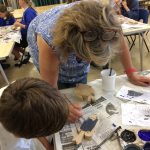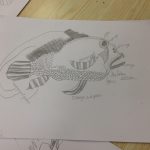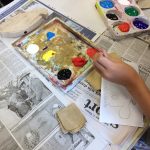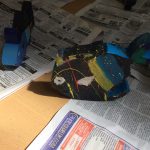Mdina Glass and Isle of Wight Studio Glass – a lecture by Mark Hill on January 8th 2018
Mark enthralled us all with his enthusiastic and informative lecture featuring the work of Michael Harris whom he described as ‘A studio pioneer’
He divided his talk into the various major developments in the life and work of Michael Harris.
The Early Years – Prior to the 1950s glass had to be made in factories, so opportunities to find a job were very limited. It was a two part process – designer then producer. Decorating the glass was mainly done by cold working – i.e. working on the glass after the piece had cooled down. Michael had become very skilled at tapping onto glass, so much so that he became known as ‘Tapper Harris’. In 1957 he joined the Royal College of Art in London. It was a time when its graduates were producing a groundswell of innovation. After he graduated Michael was not sure what he wanted to do but he produced some really good work such as this work from 1959 – Calypso Chance glass :
and the piece called ‘Ionian Bank’ in 1964 which took him 300 hours to create.
The next stage of his life was The Turning Point. In 1963/4 Michael went to Yugoslavia where he was able to handle the glass for himself. All over the world at this time there was an interest in using nature in creative works. In 1966 Sam Herman arrived from America and together he and Michael worked out a formula for making glass in small furnaces not in factories. Michael could see the commercial side of this rather than the academic. It is at this point he goes to Malta and begins the next stage of his life
Mdina Glass – Michael was very skilled at marketing and he began to use Mediterranean colours as he felt this was what people would want to remind them of their holidays. He also opened his workshop to the public.
Austere Scandinavian Modernism had replaced Victorian cut glass and Michael realised the potential for putting art into glass. By 1970 he began to see the export market across the world.
These two examples of his work from the 1970s in Malta demonstrate his use of Mediterranean colours.
As the business became very successful he brought over two glassblowers from the U.K.
The ‘Fish’ was the next period of his life. To create these pieces it was a very complex method which involved dipping coloured glass into clear glass to create a surround. The works have very ‘comfortable’ curves and are very tactile. Once he had developed the ‘Fish’ he went on to develop ‘Crizzle’ (or cracked) glass. Again it is very complex to make. Pieces of ‘Crizzle’ signed by him are very rare and therefore very valuable.
Once he had developed the ‘Fish’ he went on to develop ‘Crizzle’ (or cracked) glass. Again it is very complex to make. Pieces of ‘Crizzle’ signed by him are very rare and therefore very valuable.
Forced Changes – When Mintoff became Prime Minister of Malta he tells Michael he has to leave the island. Michael looks around for another place to site his studio and decides upon the isle of Wight. He starts completely from scratch replicating the Mdina studio but with one change – he makes only clear glass and adds colour afterwards.
Mid 70s In 1973 Michael produced the Seaward range and moves away from the Mdina style . He looks again at what people might want but he didn’t always get it right as with his ‘pink and blue swirls’
Azurene 1978. This was a major breakthrough. He set a competition for the for the final year students at the Royal College. One year the winner was William Walker and one of the prizes was that Michael would produce the winning design. So together they produced the vase with silver and gold leaf applied.
1980s – During this time Michael developed Azurene colour and finishes and also introduced pink. Azurene became incredibly successful, thus he was able to experiment and develop further ideas. He set up companies in Ireland (1978) Jersey and Guernsey (1980s) and Isle of Man (1982-5). Work signed by Michael -as seen below is clearly much more valuable
He set up companies in Ireland (1978) Jersey and Guernsey (1980s) and Isle of Man (1982-5). Work signed by Michael -as seen below is clearly much more valuable 
Michael then starts doing other things with gold and silver leaf and then experiments with colours like painting on glass.
Meadow garden produced in 1983  and Undercliff in 1987
and Undercliff in 1987 A
A
At this point he reached his peak of painting on glass – almost like Monet.
In 1980 his son Timothy joined the firm and in 1987 his wife and younger son Jonathan also joined.
The ‘Scapes’ series were produced by all four and were made by blowing the glass and then smashing it to give shards.
Flower Garden (above) was produced in 1989 and the vase below is from the Ribbons, Lace, Satin and Silk collection.
The late 80s saw Michael retreating from the works. He had huge global success and his sons had brought new ideas. In 1989 he retired to Gozo where he set up a small business with his wife.
Timothy continued hot working with his collection – Jazz, Rythm and Blues
whilst Jonathan developed his cold working and linear designs. 
Michael died in 1994 but Timothy and Elizabeth continued working together but moved the studio to Arreton where it still is today.
Mark summed up the life and work of this great glass worker by reminding us that Michael was the first studio glassmaker who combined commerce, marketing and aesthetics. He enabled studio glass to be produced on a wider scale and helped others to achieve this. His determination and willingness to take risks in pursuit of excellence make him a true pioneer.
The number of questions asked at the end of the session showed how Mark had generated such interest and enthusiasm in our audience and I am sure many of us will look afresh at glass works in antique shops and at our own collections.





























































